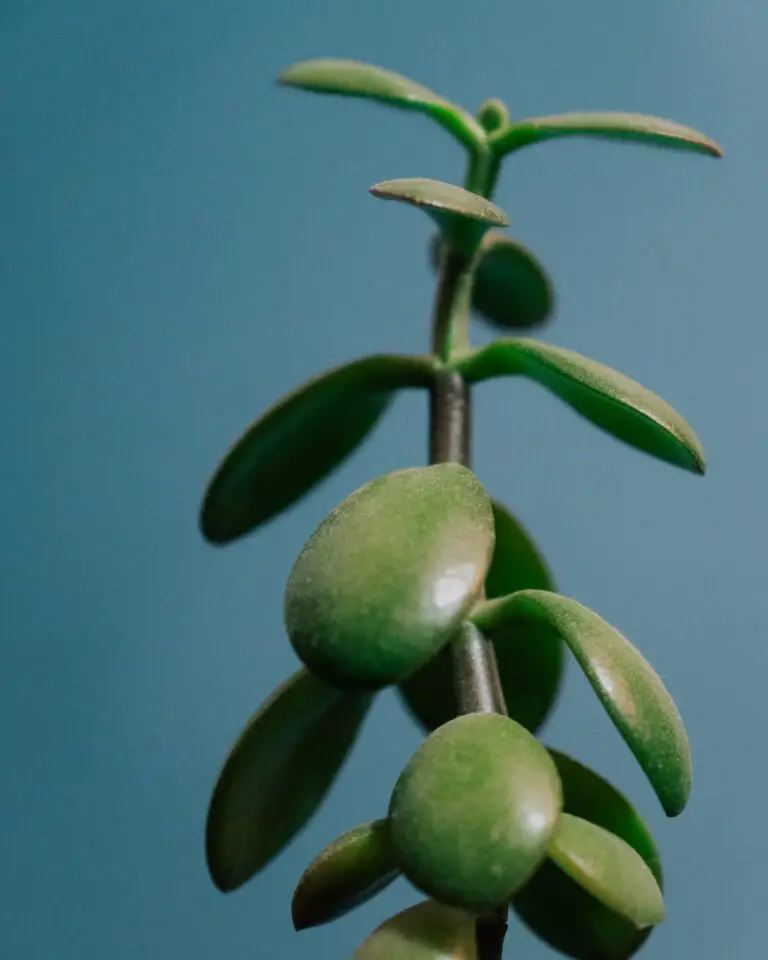Introduction to Crassula Perforata
Enter the world of succulents, and you’ll stumble upon the charming and distinctive Crassula Perforata, also known as the ‘String of Buttons’. This peculiar plant captures the hearts of garden enthusiasts not just for its ornamental beauty but also for its playful, stacked leaves that spiral around its stem like a green staircase to the skies. What truly makes it stand out in the succulent family is its ease in creating new plants from just a single leaf or stem cutting – nature’s own version of cloning!
Let’s explore the allure behind this succulent superstar. The Crassula Perforata wins popularity contests, not just for its striking appearance but also because it forgives a forgetful waterer. Its plump, jade-like leaves are adept at storing water, which comes in handy during droughts, making it an ideal plant for both seasoned and novice gardeners alike. Furthermore, propagating your own Crassula Perforata is an act of both conservation and cultivation. By doing so, you not only multiply the beauty of these succulents but also get to witness the marvel of plant development firsthand – a truly rewarding experience.
If you’re itching to learn the nuances of turning a tiny leaf into a full-grown, button-stacked beauty, let’s dive into the process in this visual treat of a tutorial:
Now, while our String of Buttons does a fabulous job of propagating on its own, caring for the parent plant requires just as much attention. Need to brush up on your succulent caretaking skills? Check out this handy guide on succulent care to ensure your emerald darling and its offspring thrive in their cozy corners of your home or garden.
Why Propagate Crassula Perforata?
Think about it: Every leaf you pluck and root is a step towards a greener habitat. The benefits of propagating Crassula Perforata are as satisfying as the process itself. You’re essentially creating life from life, expanding your green retreat without having to rush to the garden center every so often. Moreover, gifting your friends and family with these cloned cuties can introduce them to the joyous world of succulents, fostering a community that appreciates and shares in the wonders of nature.
Propagating your Crassula Perforata is not just a horticultural hobby – it’s a testament to the resilience and ingenuity of nature, allowing you to spread the joy these plants bring. As you snip, plant, and water, you’re not just cultivating succulents, you’re cultivating patience, care, and an appreciation for the small, beautiful intricacies of life.
Understanding Crassula Perforata’s Natural Propagation
If you’ve ever marveled at the robust resilience of succulents, prepare to be enthralled by the propagation prowess of Crassula Perforata. This succulent, often adorning homes with its stacked, coin-like leaves, has mastered the art of cloning itself in the wild—a skill we can keenly adapt for our home gardens.

In the sweeping landscapes of South Africa, where sunlight bathes the foliage in a warm embrace, nature’s blueprint for propagation unfolds. Crassula Perforata leaves, plump with life, may casually drop to the ground, not as a sign of despair, but of opportunity. These fallen leaves, far from perish, set roots into the embracing soil, embracing a new life as independent plants.
Observing these natural methods provides invaluable insights for domestic cultivation. Imagine: You could replicate this process at home, converting a single succulent into a verdant collection. Picture the leaves as miniature self-starters, eager to root and thrive under your care.
Now, let’s demystify this propagation process further. It’s not about the mere act of falling leaves; it’s an intricate dance of survival beyond the confines of their parent stem. Adequate light, gentle moisture, and patience are the nurturing triad that prompts these succulent offspring to flourish.
Embracing Crassula Perforata propagation at home isn’t just about plant multiplication; it’s a testament to the plant’s hearty vigor. With every leaf that roots, you’re echoing the process honed over millennia in the wild—an ode to the tenacious spirit of succulents.
Basic Conditions Required for Propagation
Welcome to the exhilarating world of Crassula Perforata propagation! Imagine being a plant’s personal matchmaker, helping it multiply and thrive. Before we dive into the nitty-gritty, let’s set the stage for where the magic happens. Picture a cozy sunroom or a bright spot on the windowsill. It’s here, under the right glow and caress of warmth, that you’ll witness the remarkable process of succulent cloning unfold.

First and foremost, temperature is key. Think mild spring days, anything too hot or too cold, and our green friends might as well be trying to flap leaves and fly away. You’re aiming for that Goldilocks zone, where it’s neither too hot nor too chilly—somewhere around 60 to 75 degrees Fahrenheit (15 to 24 degrees Celsius). This is the sweet spot that tells Crassula, “Hey, it’s time to get growing!”
The sun, oh, the radiant sun! Light is a dancer, and Crassula wants to salsa. But not all day. About six hours of indirect sunlight is what this succulent craves. Direct, harsh rays? No, thank you. It’s all about dappled shade and soft light that whispers, rather than shouts, fostering an environment where tiny replicas can sprout with gusto.
Humidity, often overlooked, is the invisible hug that nurtures our plants. Too little, and they shrivel up, too much, and they might start to rot. Aim for a balance; think of that refreshing mist that lingers after a soft rain. This moisture in the air keeps the succulents just plump enough without descending into a soggy mess.
Looking for more tips on ensuring your Crassula’s happiness? Don’t miss our in-depth guide on crassula care and cultivation where we unravel the mysteries of providing the perfect home for your succulent marvels.
Propagation through Stem Cuttings
Embarking on the adventure of propagating your Crassula Perforata is both rewarding and engaging. Imagine duplicating your favorite succulent with nothing more than a snip and some patience! Let’s get cracking on the propagation process that turns one plant into many, passing on the baton of growth to new generations.
First up, selection is key. The quest begins by choosing a healthy stem that screams ‘pick me!’—a stem that’s like the class valedictorian: sturdy, vibrant, and showing off a rosette of leaves that are the envy of its peers. This champion stem will give your cuttings the best shot at striking roots and flourishing.
Next, armed with clean, sharp scissors or a knife, you’ll make the cut. Think of it like a precise surgical move: you want a clean snip just below a node or a leaf pair. Take care not to damage the stem, as a smooth cut is your succulent’s passport to a successful rooting journey. This cut is where the magic happens – it’s where potential roots are eager to burst into life!
With the cuttings in hand, resist the urge to dunk them straight into the soil. These brave little cuttings need time to callus, forming a protective barrier from which the roots will eventually emerge. It’s their time-out period, typically taking a few days, to heal and muster up the strength for the next step. Think of it as a superhero’s origin story—the moment before greatness is unleashed.
Once the callus is formed, the rooting begins. Your cuttings, now battle-ready, take their place in well-draining soil that’s the perfect arena for root development. The soil is their training ground, preparing them for a life of stability and growth. It’s essential not to overwater during this period, as the mighty Crassula Perforata’s roots prefer to seek out moisture rather than being flooded with it. Remember, tough love goes a long way with succulents!
Throughout the rooting period, care tips for succulents can help maintain an environment where your Crassula Perforata’s stamina continues to build. Give your cuttings the occasional pep talk (light watering) and ensure they sunbathe in bright, indirect sunlight where they can bask in the glory of gentle rays. Soon enough, roots will appear, and your propagation prowess will be evident as new plants begin to flourish.
Imagine the joy as your stem cuttings, which started as little more than an offshoot, manifest into a full-fledged, root-rocking Crassula Perforata. It’s not just about growing plants; it’s about growing possibilities—each cutting, a new chapter in the story of your succulent saga.
We’ve walked through the process, but as they say, seeing is believing. Take a peek at how it’s done in the real world with this handy-dandy video. It’s like having a front-row seat to the action, where you’ll witness each step in living color and get the confidence to try it yourself. So go on, grab your gloves, and let’s multiply those Crassulas!
Leaf Propagation Methodology
Embarking on the adventure of propagating your Crassula Perforata, also affectionately known as ‘String of Buttons’, can be as captivating as a novel where you’re both the protagonist and the creator. So, let us delve into the nitty-gritty of using leaves for propagation, a method as intriguing as it is rewarding. Imagine taking a small piece of your beloved succulent and watching it take on a life of its own – the anticipation is exhilarating!
First things first, you’ll need to prepare your Crassula leaves. Select healthy, full leaves from your plant, ensuring they are free from any blemishes or damage. Much like a skilled surgeon, make a clean, precise cut – or better yet, gently twist the leaf off by hand to ensure no part of the leaf is left on the stem. This attention to detail can mean the difference between success and failure in your propagation journey.

With your leaves collected, it’s time to introduce a period of healing. Just as we need time to heal from a wound, so do the leaves from your Crassula Perforata. Allow them to rest in a dry, warm, and shaded area for a few days. This waiting period is crucial for the formation of a ‘callous’, which will protect the young propagule from rot and disease once it’s time to introduce it to soil.
Patience is key in the subsequent step – the rooting. After the callousing, place your leaves atop a well-draining succulent mix, barely touching the soil. Picture this as setting a crab free at the beach’s edge, just close enough to feel the ebbing tide. Avoid the temptation to bury the leaf, as this may encourage rot rather than growth.
And now begins a spectacle of life. With the right environmental sonnet – indirect sunlight, mild watering, and a whisper of hope – you will soon witness roots emerging hesitantly, as if testing the waters of their new world. And then, almost like magic – tiny rosettes will start to crown these roots, a clear indication that your propagation is thriving.
Remember, the journey of growth is not a race but a measured dance shared between you and your young Crassula offspring. These fledglings will demand your attention, with sporadic sips of water and the warmth of indirect sunlight. Yet, as any seasoned gardener will tell you, the bond formed in watching the slow unfurling of new life is unquantifiable – a true marvel of the plant kingdom.
Real-Life Leaf-Leaping Tales
As you embark on this process, take solace in the stories of countless enthusiasts who have walked this path before. There’s the tale of Sarah from Savannah, who transformed her dining table into a nursery for dozens of leaf-born Crassulas. Or Jake from Jersey, who discovered his living room corner, with its soft morning light, was the perfect incubator for his succulent offspring.
These experiences mold the propagation journey unique to each cultivator. Yours, too, will be peppered with moments of joy, anticipation, and boundless growth. Embrace each step with a blend of scientific curiosity and nurturing care, and you’ll find that propagating Crassula Perforata by leaf is not just a gardening task but an enriching voyage into the heart of succulent cloning.
Caring for Your New Crassula Plants
With your newly propagated ‘String of Buttons’, the true journey of plant parenthood begins. As these little Crassula perforata babies take root, it’s crucial to create an environment where they can thrive. It’s a balancing act between water, food, and love—a story every seasoned plant lover knows by heart. Let’s walk through the essential steps to ensure your succulent story has a happy, healthy chapter.
Watering: The Delicate Dance of Hydration
Imagine this: you’ve just brought home a tiny pup, and it’s time to teach it when and where to drink. Similarly, your Crassula cuttings need to learn the ropes of their new pots. Initially, keep the soil lightly moist to encourage root growth, but once those roots are established, it’s a shift to the succulent’s soundtrack—less is more. Water your Crassula when the soil is completely dry, using the soak and dry method. This mimics the occasional rain they would get in their natural habitat and prevents overwatering mishaps.
Feeding: The Nutritional Nudge for Growth
Like a fledgling bird, your Crassula offspring require the right nutrients to soar. A half-strength succulent fertilizer during the growing season can be the wind beneath their wings. Remember, a little goes a long way; over-fertilizing can lead to more harm than good. Just a nudge, once a month, should suffice. It’s the equivalent of a timely pep talk for your green babies, giving them the boost they need without overwhelming them.
Potting: The Art of the Perfect Home
Your baby Crassula’s first home is more than just a pot; it’s the cradle of their development. A well-draining soil mix and a pot with drainage holes are the real estate must-haves. This setup prevents water from overstaying its welcome and keeps root rot at bay. As they grow, they might hint at needing more room—roots peeking out of the drainage hole are a tell-tale sign. When they do, it’s moving day to a slightly larger pot where they can stretch out and grow.
Treating Common Issues: Sickness and the Succulent
Even with the best care, your Crassula plants can face some hiccups along the way. Yellowing leaves or a stretched-out appearance often cry out for help—a plea for more light or less water. Then there’s the dreaded root rot, the succulent’s silent ailment most effectively treated by prevention. If caught early, though, you can give your plant a second chance with prompt repotting and a return to the correct watering routine.
Each Crassula plant tells its own story through the way it grows and reacts to care. It’s a narrative woven with the threads of attentive observations and timely adjustments. For a deeper dive into succulent care, let’s tune into a visual tale that can guide you on this green journey:
As you tend to your Crassula plants, remember that these hardy succulents are more than just decor; they’re living sculptures that grow with your care. With patience and attention to their simple needs, you will master the art of Crassula care and perhaps unravel the joy of nurturing a piece of nature in your own space.
Troubleshooting Common Issues in Propagation
Let’s face it, cloning your Crassula Perforata can sometimes feel like a high-stakes mission with unforeseen complications. But fear not! We’re here to dissect those pesky problems and give you the upper hand in your succulent propagation saga.
When Rot Tries to Ruin the Party
Sometimes, the stem or leaf cuttings of your Crassula Perforata decide to throw a rotten party, and trust me, it’s not one you want an invite to. Rot typically creeps in when the cuttings are too moist or when they remain in waterlogged soil. It’s a silent mood killer, starting at the base and working its way up like a sneaky, unwanted guest. To avoid this, ensure your cuttings are calloused properly before planting, and keep the soil just shy of dry – think of it as the ‘moist, but not too eager’ stage.

Dry Out Dilemma: The Desiccation Conundrum
Oftentimes, eager propagators might find their Crassula Perforata cuttings turning into a crisp rather than sprouting roots. It’s like expecting a rainforest and getting a desert. The key here is balance. Those cuttings need some TLC, but not drenching. A light mist can be the life-saver, giving them that hint of hydration without going overboard.
Battling the Bug Brigade
Just when you think you’ve got the hang of it, an infantry of infestations can breach your defenses. Aphids, mealybugs, and other freeloaders can set up camp, pilfering the vital resources of your burgeoning Crassula babies. Wage war with a gentle insecticidal soap, or release some ladybug allies to assert dominance. Remember, vigilance is key—catching these critters early on is crucial in ensuring your propagation project stays on track.
Recognize that each Crassula Perforata is unique, and sometimes what works for one won’t work for another. It’s about observing, adapting, and showing unwavering spirit in the face of propagation adversity. With these tips, you’ll be well on your way to a thriving Crassula army! Keep on cloning, green thumb warriors!
Maximizing Propagation Success
The art of succulent cloning isn’t just about cutting and waiting; it’s about nurturing and understanding the subtle nuances that turn a novice gardener into a green-thumbed wizard. When it comes to Crassula perforata, an enchanting succulent with stacked leaves like a spiral staircase to horticultural heaven, the details truly matter. Care for a journey into maximizing propagation success? Let’s get our hands dirty (figuratively, of course)!
First off, timing is everything. Imagine trying to start a campfire in a downpour—it’s not going to be a cakewalk. Similarly, propagating your Crassula perforata demands the right time of year. Spring is your goldilocks zone: conditions are just right, with increasing daylight and warmth stimulating growth. Nature awakens from its slumber, and so does your succulent’s desire to multiply!
It’s not magic, but it might as well be—growth hormones can be a propagator’s best friend. Have you ever tried to bake a cake without a leavening agent? It results in a sad, flat dessert, right? The same goes for propagating your succulent. A dab of rooting hormone on the cut end of your stem or leaf can pump up the volume on root development, leading to healthier, more robust baby succulents. Just remember, a little goes a long way—this isn’t a seasoning contest!

Let’s talk about a real-life example. Picture Sarah, a propagation enthusiast with an eye for design and a heart for succulents, especially her prized Crassula perforata. Year after year, she battled with lackluster propagation results. That is, until she learned the tricks of the trade—propagating in spring and the judicious use of growth hormones. Her windowsill transformed into a verdant nursery, lush with succulent babies. All it took was tweaking the variables, and the ‘green babies’ literally sprang into action.
Now, armed with these tips and tricks, you’re well on your way to cloning your very own Crassula perforata. Whether you’re looking to greenify your home or share the love with fellow plant lovers, remember that success lies in the details. Embrace the season, invite the help of growth hormones, and watch your succulent family grow!
Consolidating Your Propagation Knowledge
As we journey together through the fascinating process of propagating Crassula Perforata, you’ve learned not just the “how-to’s” but also the “why’s” behind each step. Propagation isn’t just about replicating your beloved succulents; it’s an invitation to become a part of their story, to forge a deeper connection with these resilient wonders of nature.
Imagine having a leaf from a mother plant, reminiscent of a coin, and watching it turn into a cluster of new life. That’s the magic of propagation. And each effort you put forth—from selecting the right leaf to finding the perfect spot for it to call home—is imbued with the promise of green growth.
But here’s the clincher: no two propagation stories are the same. What works splendidly in a controlled environment might struggle on your windswept balcony. This is where your role as an enthusiast morphs into that of a scientist. Observe, experiment, and adapt. Remember, each Crassula Perforata is as unique as you are, and discovering what brings out the best in your succulents is part of the thrill.
To ensure you’re equipped with the best knowledge, let’s dive into a video that distills the essence of Crassula Perforata propagation. Watch, learn, and be inspired to start your journey of succulent cloning.
Gleaning insights from real-life examples is invaluable. Consider Jane, a fellow enthusiast, who found that her String of Buttons thrived unexpectedly well in a slightly shaded corner of her living room, away from the advice of “full sun” she had read online. Or take Bob, who discovered that his propagation mix needed that extra bit of perlite for his climate. These anecdotes aren’t just stories; they’re the lived experiences of individuals finding what works best for them.
Now, let it be your turn. Gather your leaves, find your spot, and embark on this rewarding experiment. With each new root and shoot, you’ll not only grow your garden but also your understanding of these beautiful plants. The world of propagation is both art and science, and you, my friend, are the artist and the scientist rolled into one.
Frequently Asked Questions
Embarking on the journey of propagating Crassula Perforata, you might envision a lush garden of succulents sprouting before your eyes. But wait! You’ve got questions, and we’ve got answers. Let’s dive into the nitty-gritty of helping your green friends take root.
What’s the Best Way to Start Propagating My Crassula Perforata?
Propagation might sound like a term from your high school biology class, but it’s just the process of creating new plant pals from the ones you already have. Picture this: you’ve got a healthy Crassula Perforata, also known as the ‘String of Buttons’, and want to multiply your collection. The best way to start is by taking a leaf or stem cutting. Ensure your “parent” plant is healthy, snip off a piece with a clean cut, and let it callous over for a few days. You’ve now set the stage for a new plant to flourish!
Is Soil or Water Better for Rooting Cuttings?
There’s a hot debate in the plant community about this very question. Some swear by the water method, where you can witness roots developing like a natural miracle unfolding in your living room. Others prefer the tried-and-true method of planting directly in soil, which can provide a stable environment for roots to grow. The answer? Both methods have their champions, and it really comes down to your preference. Experiment with both and see which gives your succulents that growth spurt!
How Long Does It Take to See Growth?
Imagine you’re watching a slow-motion nature documentary where a single frame captures weeks of growth. In reality, after setting your cuttings in their new home, you’ll need to arm yourself with patience. It can take several weeks to a few months for roots to develop and new growth to emerge. Much like waiting for your favorite series to drop a new season, the anticipation is part of the excitement.
What Are the Signs of Successful Propagation?
Success in succulent propagation looks like fresh green shoots or roots reaching out like curious tentacles into the soil or water. It’s like your cuttings are giving you a thumbs up, saying, “Hey, you’ve done well!” If you see new leaves forming or the cutting has anchored itself firmly, you’re on the right track.
For a real-life glimpse into rooting your Crassula Perforata, feast your eyes on this instructional video. Embrace the first-hand look at how succulents can start their journey from a modest cutting to a thriving plant.
Remember, even the greenest thumbs had to start somewhere. With these pointers, you’re well on your way to propagating your very own Crassula Perforata. Stay curious, patient, and enjoy the growth!



